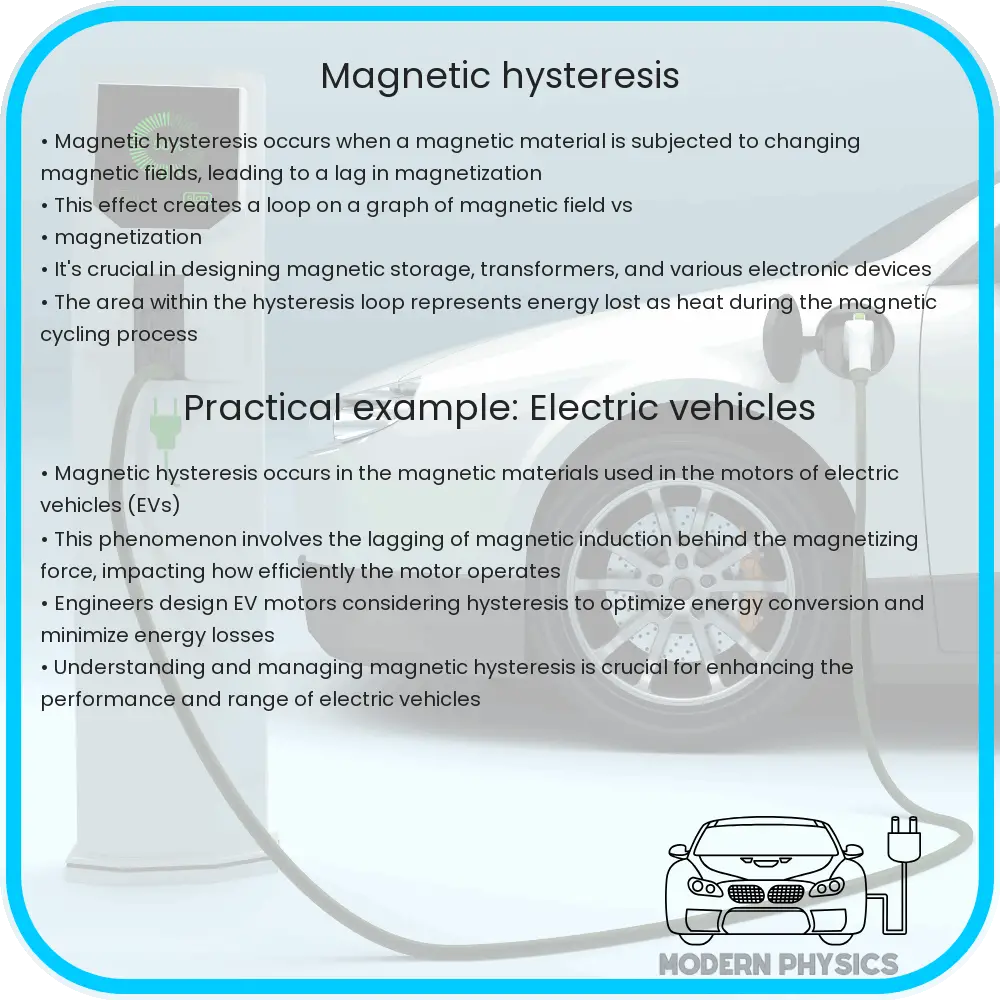Explore the principles, analysis, and diverse applications of magnetic hysteresis, including its impact on technology and future innovations.

Magnetic Hysteresis: Understanding the Basics
Magnetic hysteresis is a fundamental concept in the field of magnetism and materials science. It describes the lagging behavior of the magnetization of a material in response to an external magnetic field. This phenomenon is essential for understanding how certain materials, such as ferromagnets, behave under magnetic influences.
Principles of Magnetic Hysteresis
The key to understanding magnetic hysteresis lies in the magnetic domain theory. In ferromagnetic materials, atoms align in small regions known as domains. Each domain acts like a tiny magnet, with its own north and south poles. When an external magnetic field is applied, these domains tend to align in the direction of the field, causing the material to become magnetized. However, when the external field is removed, the domains do not immediately return to their original state. This lag in response is what we refer to as hysteresis.
The hysteresis loop, a graphical representation of this phenomenon, is crucial for analyzing the magnetic properties of materials. It plots the magnetic field strength (H) against the magnetic flux density (B). The area within the loop represents the energy lost due to hysteresis during a complete cycle of magnetization and demagnetization.
Analysis of Magnetic Hysteresis
Analyzing magnetic hysteresis involves understanding the hysteresis loop and its key features, such as coercivity (Hc) and remanence (Br). Coercivity is the intensity of the applied magnetic field required to reduce the magnetization of a material to zero after it has been magnetized to saturation. Remanence, on the other hand, is the magnetization that remains in a material after an external magnetic field is removed. These properties are critical for categorizing magnetic materials and their suitability for various applications.
Applications of Magnetic Hysteresis
Magnetic hysteresis has a wide range of applications in various fields. In electronics, it’s crucial for the design and functioning of magnetic storage devices like hard drives. In these devices, the ability of magnetic materials to retain their magnetic state after the removal of an external field is key to storing data.
Additionally, the principles of magnetic hysteresis are applied in electrical engineering, particularly in the design of transformers and inductors. The hysteresis loss in these components, a result of cyclic magnetization and demagnetization, plays a significant role in their efficiency and thermal performance.
In medical technology, magnetic hysteresis finds applications in magnetic resonance imaging (MRI). The behavior of magnetic particles under varying magnetic fields is essential for the imaging process, providing detailed images of the body’s internal structures.
Advanced Insights into Magnetic Hysteresis
Further exploration of magnetic hysteresis reveals its dependence on factors like temperature and material composition. Materials exhibit different hysteresis behaviors at varying temperatures. For instance, the Curie temperature is a critical point for ferromagnetic materials, beyond which they lose their ferromagnetic properties and, consequently, their hysteresis behavior changes significantly.
Material composition also plays a vital role in determining the characteristics of the hysteresis loop. Alloys and composite materials often display unique hysteresis properties, making them suitable for specialized applications. Scientists and engineers continuously experiment with different material combinations to develop new magnetic materials with tailored hysteresis characteristics.
Challenges and Future Directions
One of the challenges in the field of magnetic hysteresis is minimizing energy loss due to hysteresis in electrical machines and transformers. Research is ongoing to develop materials with low hysteresis losses, which would lead to more efficient devices. Furthermore, the growing field of spintronics explores the manipulation of magnetic states at the atomic level, which could revolutionize data storage and processing technologies.
Environmental concerns also drive the development of materials with more sustainable and energy-efficient magnetic properties. The recycling and reprocessing of magnetic materials are becoming increasingly important to reduce ecological impact.
Conclusion
Magnetic hysteresis is a complex yet fascinating phenomenon with far-reaching implications across various scientific and technological domains. From its fundamental principles in magnetic domain theory to its practical applications in electronics, electrical engineering, and medical technology, understanding hysteresis is crucial for advancing current technologies and developing new ones. The ongoing research and exploration in this field promise to uncover new materials and methods to harness the properties of magnetic hysteresis, pushing the boundaries of what is possible in magnetic applications. As technology continues to evolve, the significance of magnetic hysteresis and its efficient management will only become more pronounced, making it a pivotal area of study in the world of material science and engineering.
